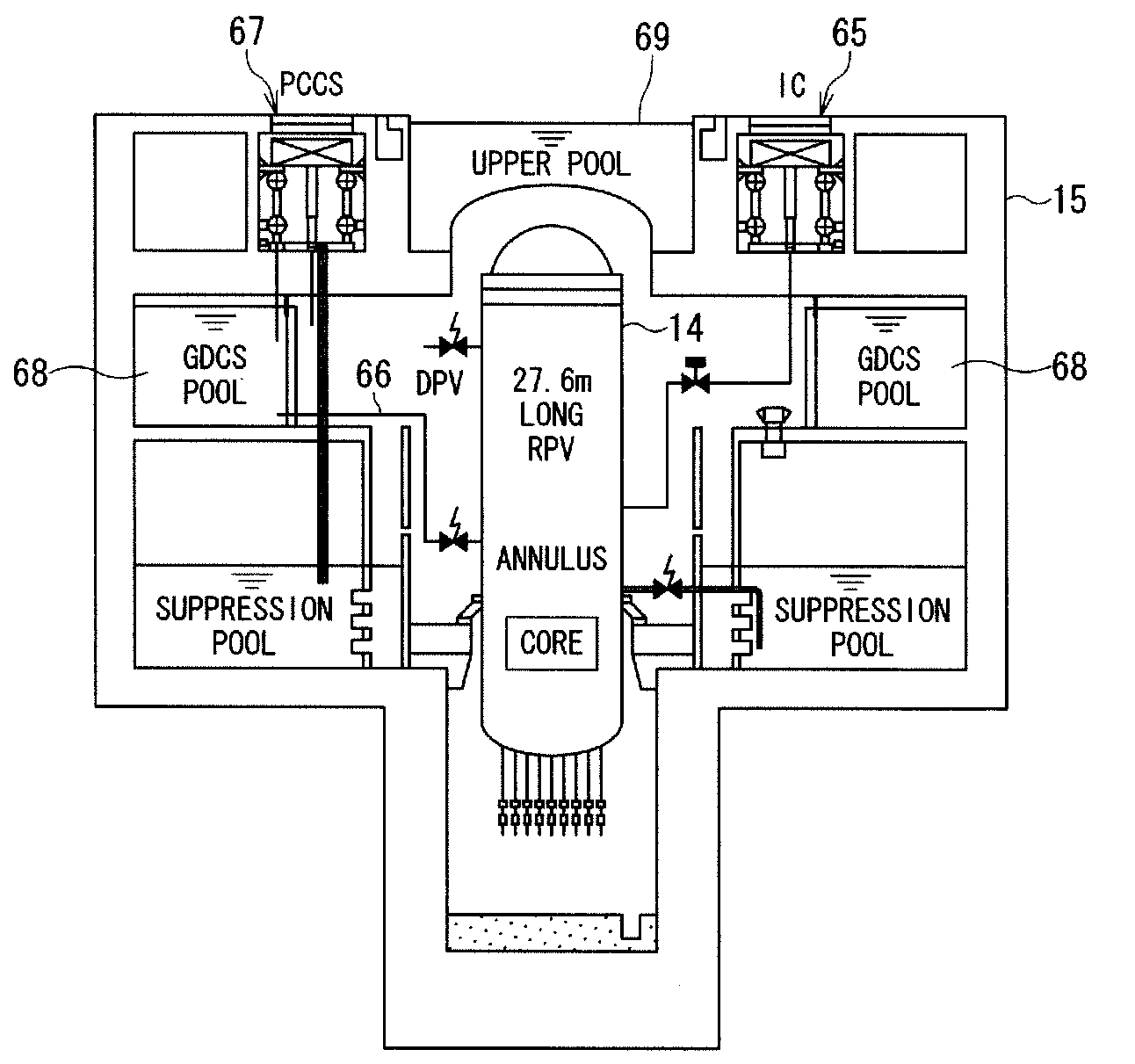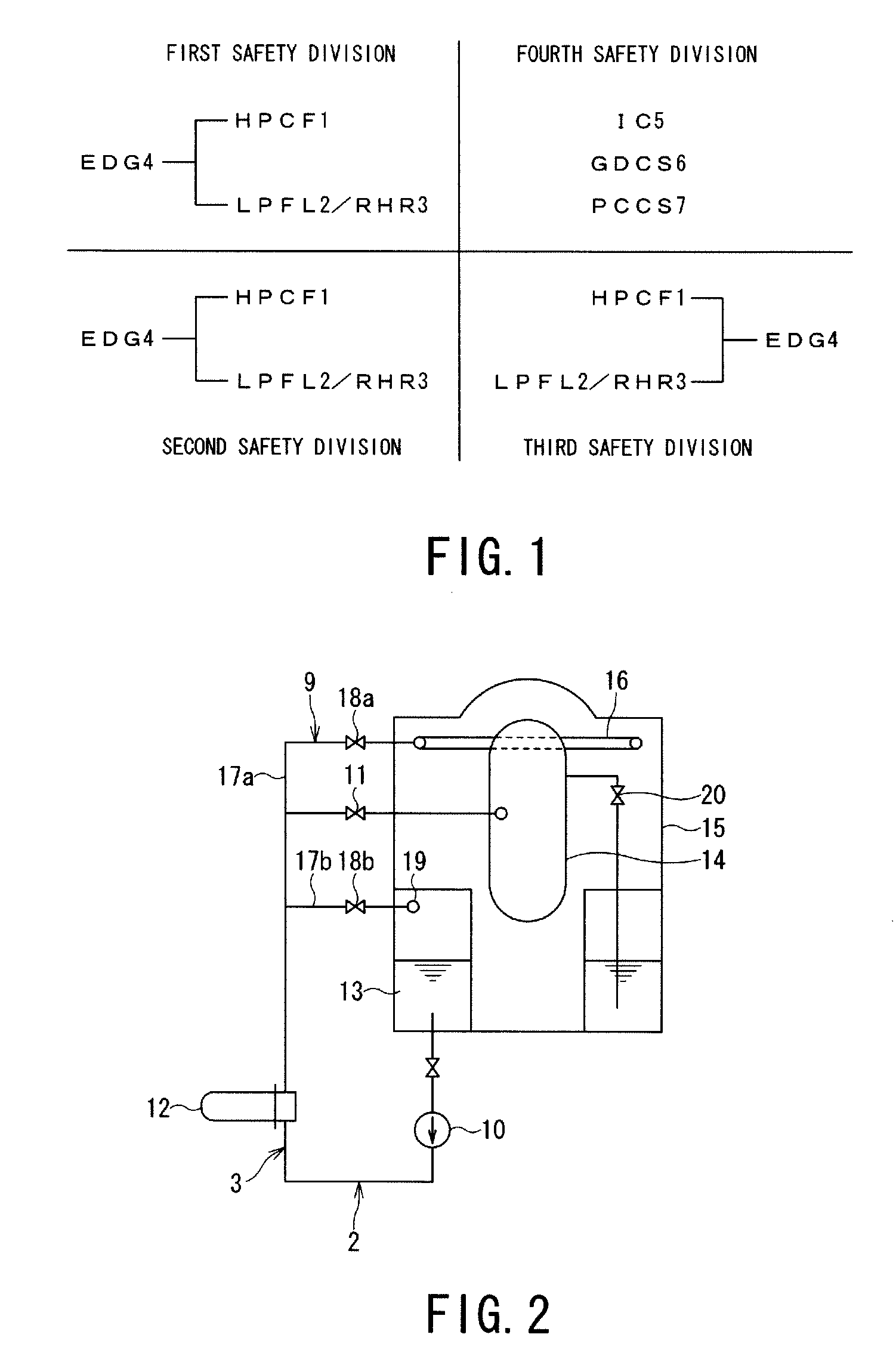Emergency core cooling system
a cooling system and core technology, applied in nuclear engineering, greenhouse gas reduction, nuclear elements, etc., can solve the problems of long time-consuming loss of ac power supply event (sbo), insufficient cooling capacity of the core, and inability to cool down the core, so as to achieve high safety and prevent internal events. high
- Summary
- Abstract
- Description
- Claims
- Application Information
AI Technical Summary
Benefits of technology
Problems solved by technology
Method used
Image
Examples
first embodiment
[0105]FIG. 1 is a division diagram showing an emergency core cooling system (ECCS) incorporated in a boiling water reactor nuclear plant (BWR), according to a first embodiment of the present invention.
[0106]The number of safety divisions of the ECCS for the BWR according to this embodiment of the present invention is four, for example.
[0107]In each of first to third safety divisions, a high pressure core cooling system (HPCF) 1, a low pressure core cooling system (LPFL) 2, a residual heat removal system (RHR) 3, and an emergency diesel generator (EDG) 4 are provided as active safety systems. Since a portion of a piping and a pump are shared with the low pressure core cooling system 2 and the residual heat removal system 3, they are indicated as LPFL2 / RHR3 in FIG. 1.
[0108]In a fourth safety division, an isolation condenser (IC) 5, a gravity-driven cooling system (GDCS) 6, and a passive containment cooling system (PCCS) 7 are provided as passive safety systems.
[0109]In the high pressu...
second embodiment
[0164]An emergency core cooling system (ECCS) according to a second embodiment of the present invention will be described hereunder with reference to FIG. 6. Upon describing the ECCS according to the second embodiment, like reference characters designate like components common to the ECCS according to the first embodiment, and the duplicated description is omitted herein.
[0165]FIG. 6 is a division diagram showing the ECCS incorporated in a BWR.
[0166]The number of safety divisions for the ECCS of the BWR according to the second embodiment is 4, for example.
[0167]In each of first to third safety divisions, the high pressure core cooling system (HPCF) 1, the low pressure core cooling system (LPFL) 2, the residual heat removal system (RHR) 3, a wet well and dry well cooling system (WDCS) 21, and the emergency diesel generator (EDG) 4 are provided as active safety systems.
[0168]Since a portion of a piping and a pump are shared with the residual heat removal system 3 and the wet well and ...
third embodiment
[0179]An ECCS according to a third embodiment of the present invention will be described with reference to FIG. 8.
[0180]Upon describing the ECCS according to the third embodiment, like reference characters designate like components common to the ECCS according to the first embodiment, and the description is omitted.
[0181]FIG. 8 is a diagram showing a division of the ECCS incorporated in a BWR.
[0182]An emergency power supply is an important apparatus, at a loss of the offsite power supply system, which supplies the power necessary for safely shutdown the nuclear reactor while supplying the power necessary for operating engineering safety facilities.
[0183]Generally, one emergency power supply is provided in each of safety divisions. The safety is assessed on the assumption that the failure of the emergency power supply is to be a single failure. Hence, it is required to assume that the entire functions of the active safety systems in one safety division are lost by the single failure ...
PUM
 Login to View More
Login to View More Abstract
Description
Claims
Application Information
 Login to View More
Login to View More - R&D
- Intellectual Property
- Life Sciences
- Materials
- Tech Scout
- Unparalleled Data Quality
- Higher Quality Content
- 60% Fewer Hallucinations
Browse by: Latest US Patents, China's latest patents, Technical Efficacy Thesaurus, Application Domain, Technology Topic, Popular Technical Reports.
© 2025 PatSnap. All rights reserved.Legal|Privacy policy|Modern Slavery Act Transparency Statement|Sitemap|About US| Contact US: help@patsnap.com



